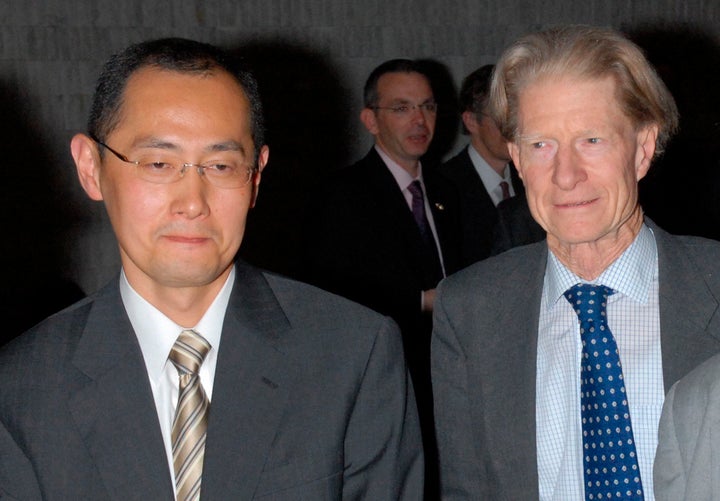
A quintessential English gentleman educated at Eton and a Japanese orthopedic surgeon. Not the most likely of traveling companions, you might think. But very soon the two of them will be journeying to Stockholm to collect the Nobel Prize for Physiology or Medicine, for research carried out on different continents, using different animal species and decades apart, yet intimately linked. The work of both men is elegant and beautiful and has one of the features that characterizes the truly revolutionary in biology -- as soon as you understand it, it seems so self-evident that it's hard to believe no one had ever thought of it or done it before.
Sir John Gurdon is in his seventies and is still an active researcher, seemingly unfazed by the fact that his laboratory at the University of Cambridge is now in a building named after him. For over twenty years from the 1960s onwards he carried out a long series of research programs using a wonderfully ugly toad, called Xenopus laevis, which lays lots of very big eggs outside her body.
Gurdon harvested these and carefully removed the nucleus from an egg. The nucleus is the part of the cell that contains all the genetic information, the DNA. He put into this "empty" egg a nucleus that he'd taken out of a different type of toad cell, for example from the gut, and let the egg develop. And it did, leading to the production of tadpoles. It was the first example of cloning, taking a cell from the body and using its nucleus to create a whole new organism
Now this is the forerunner to the production of Dolly the Sheep many years later when Keith Campbell and Ian Wilmut performed a conceptually similar technique to create the first cloned mammal. And Gurdon's work would be important for that alone, but the real reason why he has won the Nobel Prize is because he solved a very big mystery in biology. Animals reproduce when an egg is fertilized by a sperm. The large cell that is produced has the potential to form all the cells of the body. It divides to form two cells, these divide to form four and so on, resulting in the fifty trillion cells or so in a human, for example. But as all these cells are created, they become more and more specialized, becoming different cell types. And they stay as those specialized cell types. It's why we don't get hearts in our brains or teeth in our eyeballs.
The big question was why these cells stay so specialized. There was a perfectly sensible theory that suggested that the cells jettisoned or permanently inactivated any genes they didn't need. A brain doesn't need to produce the proteins that are used when your biceps contracts (no matter how many times people say it in self-help books, the brain is not another muscle) and your ear has no need of the genes for eye color. Perhaps cells just got rid of genes they didn't need?
John Gurdon's research showed that this wasn't the case. Because he could create new toads using the nucleus from the specialized cells of older animals, it was clear that these cells kept all the genetic material required to re-create life. They just weren't using it.
Shinya Yamanaka was just a small boy in Japan when John Gurdon performed many of his key experiments. He became fascinated by stem cells, the ones which have the potential to form all the tissue types in the body. These include that starting cell created when an egg and sperm fuse, those cells created by John Gurdon that could generate entire tadpoles, and also the famous embryonic stem cells. Over twenty genes had been identified that were required for the function of stem cells and virtually everyone working in the field assumed that these would act in an almost impossibly complex network. But Yamanaka took an incredible gamble. He began testing combinations of these genes to see if they would turn specialized mouse cells into stem cells. He was attempting to achieve for thousands of cells simultaneously in a culture dish the same thing that Gurdon had done laboriously with individual toad eggs. Incredibly, Yamanaka found that he could create stem cells, simply by forcing the specialized cells to express really high levels of just four particular genes.
At first no one really believed this could be right. It was like setting off on a quest for the Holy Grail and finding it in the second place you looked, behind the bag of frozen peas in the icebox. But soon other labs repeated the finding and a whole new field of research began. This work went from "you can't be serious" to the Nobel Prize in six years -- that's how transformational it is.
Yamanaka's work is the driving force not just for a greater understanding of cell fate, but also for the generation of entire new industries. Using his techniques scientists can now create effectively unlimited supplies of stem cells from any individual. These can in turn be converted into potentially any cell type in the body. Imagine the possibilities. We could replace cells lost in diseases, from those that produce insulin in the pancreas of patients with type 1 diabetes, to the brain cells destroyed in Parkinson's disease. We could produce unlimited banks of red blood cells for transfusions for trauma patients. And we'd have none of the ethical controversies associated with embryonic stem cells, and no immune rejection because we could make cells specific to an individual patient.
For various technical reasons we aren't ready to use these cells to treat patients yet, but banks of them are being created to help scientists investigating specific diseases, and for testing new drugs.
Gurdon and Yamanaka have transformed the biological landscape with research that was conceptually beautiful, and technologically at the limits of what could be achieved at the time. The Nobel committee has made a fabulous choice.